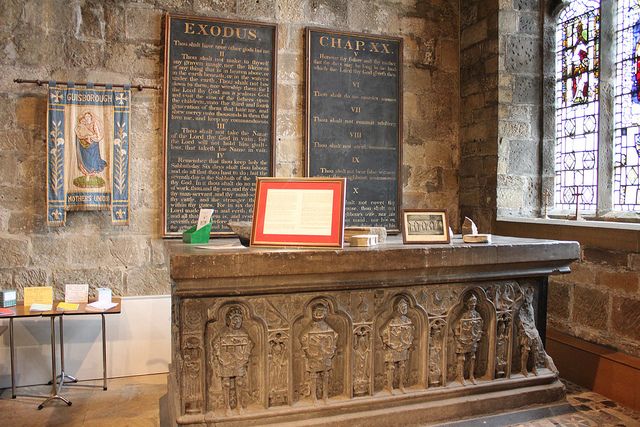Uploader's Comments
The monument, which is a cenotaph in the form of a table tomb, 9 ft. long by 3 ft. 8 in. wide, was removed from the priory to the parish church sometime after the Dissolution, and in 1661 it was engraved by Hollar in the second volume of Dugdale's Monasticon. The engraving shows the south side and west end, and is a 'fairly accurate though somewhat conventional representation'; in matter of detail, however, the accuracy is far from perfect. John Warburton, the herald, c. 1718, gives a rough drawing of the north side, and states that the tomb stood 'near to the entrance or the west door,' and that the churchwardens' seat was fixed upon it so that 'no inscription' could be seen. It is probable, however, that only the two sides were then in the porch, and that the tomb had originally been placed in the south-west corner of the chancel, where the base remained till quite recently. Some time early in the 18th century the monument appears to have been removed, the sides fixed in the porch, and the top used for the communion table. The ends, however, seem to have been differently treated, that facing east being afterwards taken to Hardwick Hall, near Sedgefield, co. Durham, where about 1754 John Burdon was embellishing the park with sham ruins and other ornamental buildings, and where it remained till it was removed about 1865 by Admiral Chaloner, who placed it in the priory ruins. The west end has been lost, but it is quite possible that it also was taken to Hardwick, and that it may still be there. At the time of the last restoration of the church the various parts of the monument were brought together and the tomb re-erected in its present position. It is composed of six slabs of carboniferous limestone, the sides being 11 in. in thickness and the moulded portion of the top 9 in. The sides are ornamented by a series of shallow niches with trefoiled heads, five on each side, and between them in both cases four smaller niches with semicircular heads and trefoil cusping. Above each of these smaller niches is a shield of square pointed form. The larger niches contain statuettes of knights in armour, those on the south representing the Bruses of the Scotch or Annandale branch, and the others the English Bruses of the Danby and Skelton line. The English knights hold shields with the lion of Brus on their breasts with both hands, while the figures on the Scotch side carry heraldic shields on their left arms. The figures on the English side represent Adam I, Adam II, Peter I, Peter II and Peter III (d. 1272), and those on the Scotch side Robert I, William, Robert III, Robert IV (the competitor) and Robert V. On the English side the four small niches are filled with figures of the four doctors of the church, St. Augustine, St. Gregory, St. Jerome and St. Ambrose, standing on pedestals of semi-octagonal form representing carved capitals. The four shields above are carved with (1) the arms of the priory, (2) a mitre transfixed by a crozier, (3) a cockstanding on a reel and (4) a falcon or eagle with wings displayed, holding in its claws a gimmel ring. The spandrels contain representations of the full moon and stars, the sun in splendour, a paten, a chalice, a pilgrim's shell and three scrolls. On the south, or Scotch, side the small niches contain figures of the four Evangelists, the shields above bearing their respective symbols. The carvings in the spandrels chiefly have reference to the Passion, the sacred foot, the sacred hand pierced by an awl, a purse or bag of money and a chalice being represented. There is also a shield charged with three castles or possibly dice boxes, and the device of the cock and reel which here occurs may in this case have reference to the Passion. Two of the spandrels are carved with human figures (orangels); one is obliterated and the other has an object like a lantern. The backs of the niches in which the knights stand are decorated with blind tracery, and the recesses are more deeply cut on the south side. At the north-east angle the end slab overlaps the side and is carved on the return end with a figure of the Virgin crowned standing on a pedestal within a long and narrow niche, above which is a shield with the Tudor rose, the whole forming a feature distinct from the other work on the north side. The east end of the monument has an arcade of three niches supported by small corbels, the whole of the space below being occupied by a group of figures representing the prior seated, habited in cassock and cloak and holding on his knee with both hands a shield with the arms of the priory. On either side kneel groups of canons, six to the left and ten to the right, the latter being partly carved on the return end of the south slab. The spandrels of the arcade contain a figure bearing a staff (probably a pilgrim), the Virgin crowned with our Lord in her arms and surrounded by rays of glory, and the cock and reel again. The lost west end is now replaced by a plain slab. The drawing in Dugdale shows it to have been carved with the figure of a king standing attired in a longrobe and cloak and wearing a crown. His right hand holds a sceptre, while his left supports a shield charged with the royal arms of Scotland. He is supported on either side by smaller figures wearing crowns but clad in armour, the three probably representing Robert Brus, his father and grandfather.
Uploaded by Antony Cairns on 16 July 2011




























